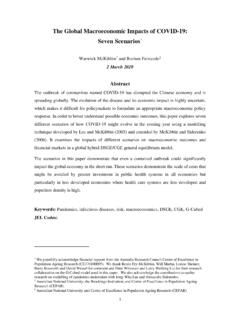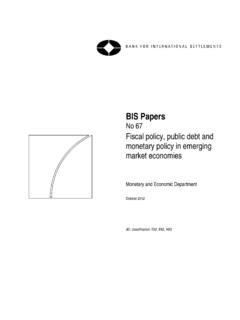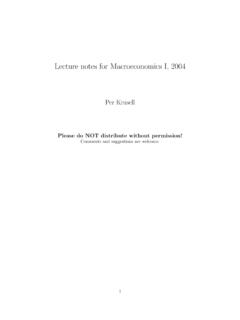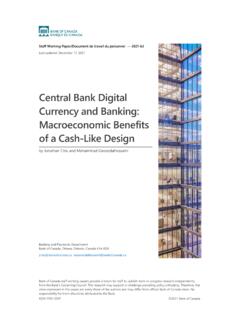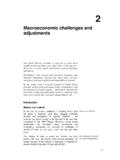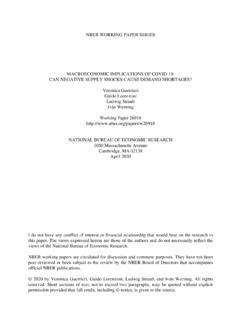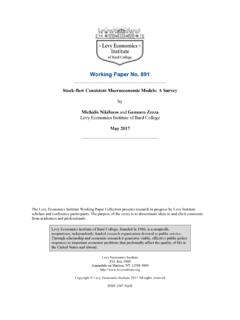Transcription of Macroeconomic stability, inclusive growth and employment
1 Macroeconomic stability, inclusive growth and employment Thematic Think Piece ILO*, UNCTAD, UNDESA, WTO The views expressed in this paper are those of the signing agencies and do not necessarily reflect the views of the United Nations. May 2012 *The views expressed in this paper are the reflections of ILO senior officials identified to assist the UN System Task Team and do not necessarily reflect the views of the ILO. 2 Following on the outcome of the 2010 High-level Plenary Meeting of the General Assembly on the Millennium Development Goals, the United Nations Secretary-General established the UN System Task Team in September 2011 to support UN system-wide preparations for the post-2015 UN development agenda, in consultation with all stakeholders.
2 The Task Team is led by the Department of Economic and Social Affairs and the United Nations Development Programme and brings together senior experts from over 50 UN entities and international organizations to provide system-wide support to the post-2015 consultation process, including analytical input, expertise and outreach. 3 Macroeconomic stability, inclusive growth and employment 1. Introduction Around 900 million adults in the developing world are unable to earn enough to keep their families above the US$ 2-a-day per person poverty line; 200 million people are unemployed globally, among them 75 million young people; hundreds of millions more work long hours under inhumane conditions and with no job security in the informal economy.
3 Poverty remains either a stark reality or a real threat for the majority of workers in the developing world, despite the rapid economic growth that has characterised many regions over the past decade. Productive and decent employment is the most important source of income security. In order to generate decent employment at the required scale, countries will have to achieve sustained and inclusive growth , which in turn critically depends on supportive Macroeconomic policies. For this reason, questions of Macroeconomic stability, employment generation and inclusive growth should be more prominently reflected in the post-2015 development agenda.
4 2. Macroeconomic stability and growth The recent financial crisis has highlighted the damaging impacts on living standards that can result from Macroeconomic instability. Large swings in economic activity, high inflation, unsustainable debt levels and volatility in exchange rates and financial markets can all contribute to job losses and increasing poverty, endangering progress towards achieving the MDGs. Maintaining Macroeconomic stability therefore is a prerequisite for sustained and inclusive development. The broad objective of Macroeconomic policy is to contribute to economic and social well-being in an equitable and sustainable manner.
5 Because unemployment and 4 underemployment are the main causes of poverty, a critical task is to maintain the economy as close as possible to full employment . This target implies that in developing countries, employment in the formal sector at least keeps up with labour force growth and rural-urban migration. Continued and sustained economic growth is not only a precondition for employment generation, but also provides countries the fiscal space to address other critical social concerns, such as access to health services, sanitation and safe drinking water, and others. growth has therefore been a critical factor in reducing global poverty over the last two decades.
6 Accordingly, the primary goal of Macroeconomic stabilization policies should be to achieve stable economic growth . This key policy objective is complemented by the need to stabilize intermediate variables that can have a strong impact on growth . Price stability and external balances in particular play an important role through their impact on investment decisions. To achieve these intermediate goals, countries need policy space to use Macroeconomic tools flexibly, including counter-cyclical fiscal and/or monetary policies, appropriate investment and exchange rate regimes, and strong financial sector regulation and supervision.
7 Country-level policy space needs to be complemented by policy coordination on a global level, especially between areas of systemic importance. 3. policy coherence for economic growth In addition to active Macroeconomic policies, countries that have achieved sustained economic growth have used a range of supportive policy interventions. They involve a country-specific mix of trade, finance and investment policies, along with active labour market and social policies. However, certain common features can be identified. First, it is primarily the private sector that invests, innovates, and trades. It is an important stakeholder in any country s broader development strategy.
8 However, to play this role, companies rely on functioning infrastructure, public education and research, and access to credit and business services. Current gaps are particularly glaring in rural areas and for micro-, small and medium-sized enterprises, and addressing them will require a sustained public effort and international support, for example through aid for trade, reliable access to development finance and public investments in infrastructure. 5 Second, scale matters. Structural transformation, which is at the heart of a dynamic growth process, requires large investments. Developing countries often lack local enterprises of sufficient scale to finance such investments and to manage large-scale projects that facilitate industrial and technological upgrading.
9 More attention needs to be given to building and regulating medium to larger sized enterprises, so that the links between profits and domestic reinvestment are strengthened. Third, successful countries have coherent Macroeconomic , employment , trade, industrial, environmental and social policies. Only when these policies mutually reinforce each other can they bring about sustained economic growth . policy coherence at the national level has to be complemented by policy coherence at the international level, providing countries with the policy space to implement their national development strategies. Fourth, coherent policies require a capable state.
10 Efficient and accountable state action is essential for the management of large-scale economic and social change. The state is the only institution that can conduct such policies and that is (or, at least, is potentially) accountable to the general citizenry for its decisions. If there are institutional weaknesses and governance deficits, they must be confronted at every level of development. Regardless of its preferred policy goals and instruments, any successful state must be able to strengthen its own capacities to promote learning and cooperation and to deepen the institutional networks that are needed by non-government actors to support long-term growth and innovation.










